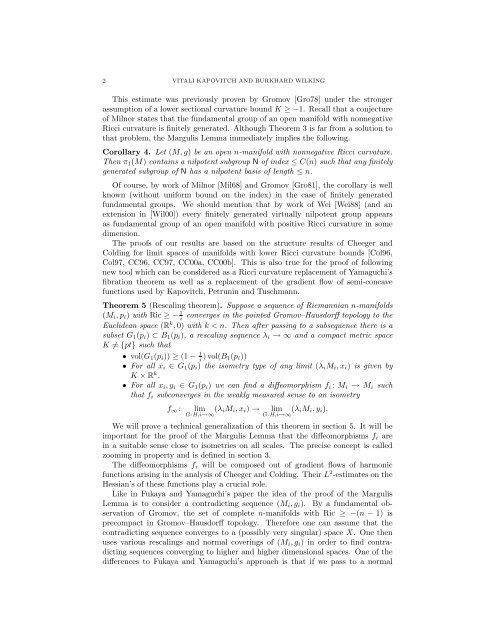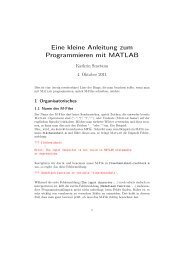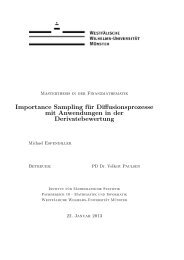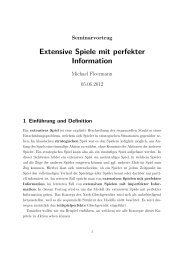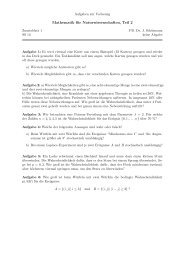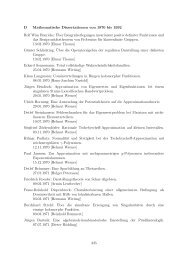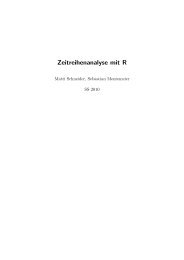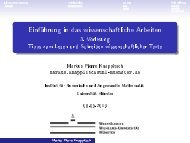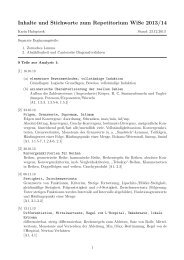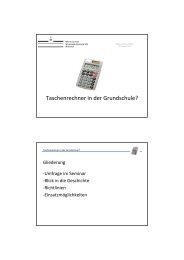Margulis Lemma
Margulis Lemma
Margulis Lemma
Create successful ePaper yourself
Turn your PDF publications into a flip-book with our unique Google optimized e-Paper software.
2 VITALI KAPOVITCH AND BURKHARD WILKING<br />
This estimate was previously proven by Gromov [Gro78] under the stronger<br />
assumption of a lower sectional curvature bound K ≥ −1. Recall that a conjecture<br />
of Milnor states that the fundamental group of an open manifold with nonnegative<br />
Ricci curvature is finitely generated. Although Theorem 3 is far from a solution to<br />
that problem, the <strong>Margulis</strong> <strong>Lemma</strong> immediately implies the following.<br />
Corollary 4. Let (M, g) be an open n-manifold with nonnegative Ricci curvature.<br />
Then π 1 (M) contains a nilpotent subgroup N of index ≤ C(n) such that any finitely<br />
generated subgroup of N has a nilpotent basis of length ≤ n.<br />
Of course, by work of Milnor [Mil68] and Gromov [Gro81], the corollary is well<br />
known (without uniform bound on the index) in the case of finitely generated<br />
fundamental groups. We should mention that by work of Wei [Wei88] (and an<br />
extension in [Wil00]) every finitely generated virtually nilpotent group appears<br />
as fundamental group of an open manifold with positive Ricci curvature in some<br />
dimension.<br />
The proofs of our results are based on the structure results of Cheeger and<br />
Colding for limit spaces of manifolds with lower Ricci curvature bounds [Col96,<br />
Col97, CC96, CC97, CC00a, CC00b]. This is also true for the proof of following<br />
new tool which can be considered as a Ricci curvature replacement of Yamaguchi’s<br />
fibration theorem as well as a replacement of the gradient flow of semi-concave<br />
functions used by Kapovitch, Petrunin and Tuschmann.<br />
Theorem 5 (Rescaling theorem). Suppose a sequence of Riemannian n-manifolds<br />
(M i , p i ) with Ric ≥ − 1 i<br />
converges in the pointed Gromov–Hausdorff topology to the<br />
Euclidean space (R k , 0) with k < n. Then after passing to a subsequence there is a<br />
subset G 1 (p i ) ⊂ B 1 (p i ), a rescaling sequence λ i → ∞ and a compact metric space<br />
K ≠ {pt} such that<br />
• vol(G 1 (p i )) ≥ (1 − 1 i ) vol(B 1(p i ))<br />
• For all x i ∈ G 1 (p i ) the isometry type of any limit (λ i M i , x i ) is given by<br />
K × R k .<br />
• For all x i , y i ∈ G 1 (p i ) we can find a diffeomorphism f i : M i → M i such<br />
that f i subconverges in the weakly measured sense to an isometry<br />
f ∞ :<br />
lim (λ iM i , x i ) → lim (λ iM i , y i ).<br />
G-H,i→∞ G-H,i→∞<br />
We will prove a technical generalization of this theorem in section 5. It will be<br />
important for the proof of the <strong>Margulis</strong> <strong>Lemma</strong> that the diffeomorphisms f i are<br />
in a suitable sense close to isometries on all scales. The precise concept is called<br />
zooming in property and is defined in section 3.<br />
The diffeomorphisms f i will be composed out of gradient flows of harmonic<br />
functions arising in the analysis of Cheeger and Colding. Their L 2 -estimates on the<br />
Hessian’s of these functions play a crucial role.<br />
Like in Fukaya and Yamaguchi’s paper the idea of the proof of the <strong>Margulis</strong><br />
<strong>Lemma</strong> is to consider a contradicting sequence (M i , g i ). By a fundamental observation<br />
of Gromov, the set of complete n-manifolds with Ric ≥ −(n − 1) is<br />
precompact in Gromov–Hausdorff topology. Therefore one can assume that the<br />
contradicting sequence converges to a (possibly very singular) space X. One then<br />
uses various rescalings and normal coverings of (M i , g i ) in order to find contradicting<br />
sequences converging to higher and higher dimensional spaces. One of the<br />
differences to Fukaya and Yamaguchi’s approach is that if we pass to a normal


